41:44.01N 12:14.06E

Muskrat
Chris and Alison
Tue 27 May 2025 11:11
27/5/25 After leaving Capraia we managed to sail most of the way down the coast over the next 3 days to Porto Turistico Di Roma a full service marina where we planned to spend the next 4 days exploring Rome. In the end we stayed a week, visiting this exciting city. Day one: Ostia Antica. Ostia was originally on the coast, but over the centuries silt from the Tiber has shifted the coastline further west and the site is now several km from the sea. Ostia was once Rome’s main commercial port and a military base, protecting the mouth of the Tiber. It continued to flourish through imperial times until the 4th century, when the harbour began to silt up, covering the old city with sand and mud. The ruins are remarkably well preserved and give a good picture of life under the Roman Empire. People of all social classes and from all over the Mediterranean lived and worked here. Day Two: St Peter’s Basilica and the Vatican City. The site where St Peter was martyred and buried, the Vatican became the residence of the popes who succeeded him. We climbed the dome (500 ish steps) to get a close up of the awe-inspiring paintings and the view down into the Basilica. The papal palaces beside St Peter’s include the Vatican Museums, Michelangelo’s Sistine Chapel and the Raphael Rooms. Taking in the wonderful collections of classical sculpture’s and paintings over the 4 miles of museums is exhausting; we hardly stopped all day. Day Three: Roman Forum, Colosseum, Palatine Hill. The Roman Forum was the scene of public meetings, law courts and gladiatorial combats and was lined with shops and open-air markets. It was also the site of many of the city’s key temples and monuments. The Colosseum was built by enslaved Jewish people on the marshy site of a lake in the centre of Rome. The Colosseum was the arena where deadly gladiatorial combats and wild animal fights were staged by the emperor and wealthy citizens for public viewing, free of charge. Under the stadium is a vast network of cages, narrow passages, walkways and lift shafts that housed and hoisted the wild animals up to the arena ready to be “hunted”. It was also the place were the gladiators waited for their fight and also stored staging for performances that were regularly performed. Palatine Hill. The centre most of the seven hills of Rome, it was once the residence of the emperors and aristocrats and is the most pleasant of Rome’s ancient sites. The remains of elaborate fountains, colourful marble floors, fine stone carvings, columns, stuccoes and frescoes can be seen within the walls of the imperial places. Palatine Hill is a green haven, shaded by pines, with wild flowers growing among the ancient ruins. The hill offers fantastic views of the Roman Forum, the Colosseum, the Capitoline Hill and the Circus Maximus. One could spend a couple of days just here to take it all in. Day four: By now we needed to get away from the crowds. We had done very well so far, bearing up to packed Piazza’s, queuing to get through airport style security at every turn, queuing to get into the sites, even though we had “jump the queue” tickets. So a day in the green spaces of Caracalla and Aventine area’s was called for. Therefore it was with a sigh of relief that we stepped off the train to find ourselves in open streets with no crowds and ancient sites almost empty. Completed by Emperor Caracalla in 217 AD, the Caracalla Baths functioned for around 300 years until the aqueducts feeding them were sabotaged by invading Goths. This is one of the most enjoyable and best-preserved ancient sites in the city. Over 1600 bathers at a time could enjoy the facilities, which included not only baths and gymnasia, but also gardens, a library, art galleries, lecture rooms and shops selling food and drink. There was even a large swimming pool and around the sides of the pool were Roman board games marked out in the marble edging of the pool for people to play while they were taking a dip, apparently the Romans loved their board games. We both enjoyed our time in Rome but have come to the conclusion that tourist area’s are not for us. The crowds, at times, were more overwhelming than the sites themselves, over priced food and drink, the risk of pick-pocketing that kept you on your guard all the time, people trying to sell you fridge magnets trinkets, and the selfie taking photo shoots that were more about the image of the person in the photo than the ancient site that they were supposed to be visiting (I think I must be getting old). Time to move on to Corsica. 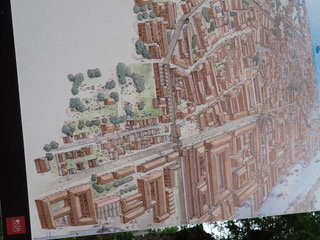 Ostia Antica as it was in its heyday. 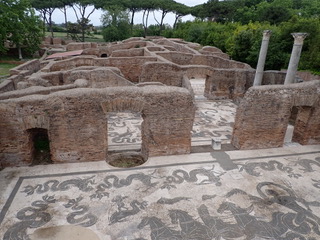 Ostia Antica now 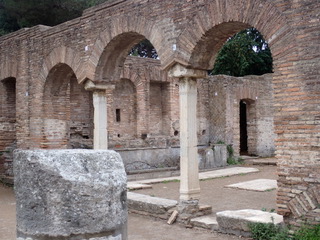   St Peter’s Basilica 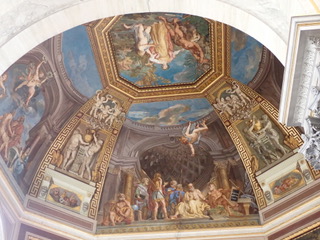  Roman Forum 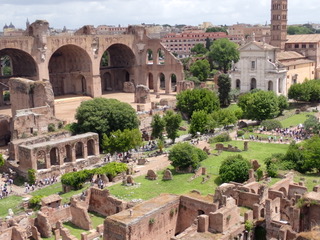 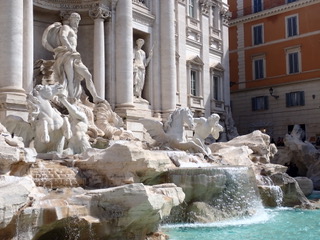 Trevi Fountain  Colosseum  Baths of Caracalla |